One of the most frequently asked questions we receive is: ‘What type of flooring can you use with underfloor heating?’. There are many things to consider with each option, so it’s important to fully understand what types of flooring are suitable for underfloor heating.
The most commonly used flooring types for underfloor heating, in order of popularity, are:
- Tiles/natural stone – Porcelain, ceramic, granite, marble, travertine etc.
- Vinyl – Karndean, Amtico etc.
- Engineered wood – usually 14mm-18mm
- Solid wood – 22mm max
- Carpet – max 2.5 tog rating
But why are some more popular than others? There are many things to consider when choosing flooring for underfloor heating, such as thermal conductivity, insulation properties, style, etc., all of which ultimately affect your decision.
Let’s take a closer look at the 5 most popular flooring choices for underfloor heating, exploring how well suited they are, as well as which flooring types you might want to avoid.
Tiles/Natural Stone Flooring
Due to the rise in popularity of open-plan living, large tiled areas in houses are now commonplace. Now more than ever, homeowners are recognising the advantages of flooring that is easy to clean and durable, as well as being stylish. Selecting a flooring type for underfloor heating isn’t just about looks; you need to consider how well it performs, whether it's easy to maintain, and how compatible it is with your heating system.
Materials such as porcelain, granite, and ceramic have the best thermal conductivity and therefore produce the best heat output with underfloor heating systems. The heat transmission characteristics of tiles etc can also be beneficial in that they hold on to heat for a long time after the underfloor heating system is turned off, which means that the room will be kept warmer for longer. The slight negative is that these materials are naturally cold, meaning the floor could feel less cosy in spaces where the heating system isn't used very often.
Typical heat output is around 130-150W/m²
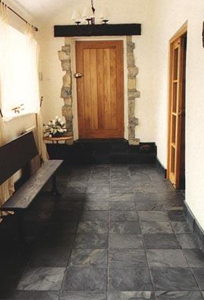
Certified Vinyl Flooring
Vinyl conducts heat well due to its low thermal resistance and thin composition, meaning warmth from your underfloor heating system is transferred quickly and evenly. Brands such as Karndean and Amtico provide certified vinyl that has the appearance of wood, tiles, stone, etc. The material has the advantage of being naturally quite warm. So, if you’re wondering what type of flooring you can use for underfloor heating, vinyl is a great choice as it's effective and there is a wide range of styles and finishes to choose from.
Typical heat output is around 100-120W/m²
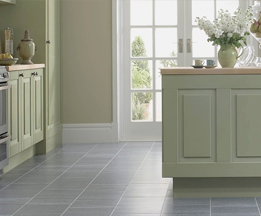
Engineered Wood Flooring
As with tiles, engineered wood has also seen an increase in popularity due to the rise in open-plan spaces. While pure wooden flooring is a less effective choice due to its insulating properties, engineered wood is a much better option as it allows for more heat transfer. Engineered wood is made up of layers of plywood and solid wood (usually 14mm in total), which makes it a great choice for flooring for underfloor heating. The floor will feel pleasantly warm but not hot underfoot.
Typical heat output is around 95-115W/m²
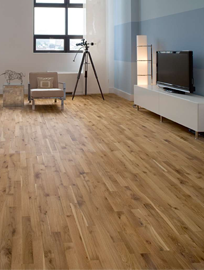
Solid Wood Flooring
Are you wondering whether you can have underfloor heating with wooden floors? Well, the answer is yes, but there are some important things to consider. Solid wood flooring is typically 18-22mm thick, and as previously mentioned, it’s an insulator. So be aware that opting for solid wood flooring for your underfloor heating system could mean there is less heat generation. If you have your heart set on wooden flooring, we always recommend choosing engineered wood for your underfloor heating system. This is because engineered wood allows heat to be transferred easily, meaning your heating system can run more efficiently.
Typical heat output is around 80-95W/m²
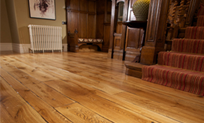
Carpet
Can you have carpet with underfloor heating? Yes, it is possible to lay carpet on top of your underfloor heating, but there are a few things you need to take into account first. For example, if your carpet is too thick and insulating, it can block the heat from rising, meaning you won’t feel the full benefits of your underfloor heating system.
All carpets have a tog rating, which indicates how insulating the carpet is. The best carpets to use with underfloor heating are those with tog ratings of less than 2.5 (including insulation). Your supplier will be able to tell you the combined tog rating of the carpet/underlay.
Typical heat output is around 70-85W/m²
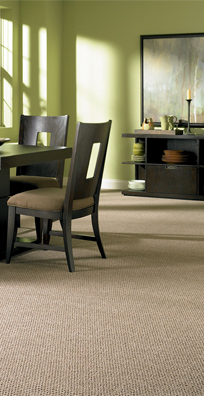
Heat Output Comparison by Floor Covering
| Floor Covering | Flow temp. | Pipe Spacing | Room Temperature | Heat Output W/m² |
| Tiles | 50° | 200mm | 22° | 130 |
| Vinyl | 50° | 200mm | 22° | 101 |
| Engineered wood | 50° | 200mm | 22° | 96 |
| Solid wood | 50° | 200mm | 22° | 83 |
| Carpet | 50° | 200mm | 22° | 72 |
Flooring Types to Avoid with Underfloor Heating
Thick Carpets
As we explored, thick carpets are not a suitable flooring for underfloor heating, as they are too insulated to allow your underfloor heating system to reach its full potential. All the heat ultimately gets trapped where you won’t feel its effect, making it ineffective and ultimately more costly to run.
Solid Wood
While it is possible to have solid wood flooring above your underfloor heating system, it isn’t advised. This is because solid wood is an insulator, and is also prone to expanding with heat, leading to warping over time.
Non-Certified Vinyl
Using a non-certified vinyl flooring for your underfloor heating can result in costly maintenance and replacement. Non-certified vinyl is known to become damaged or discoloured over time when exposed to heat, so we always recommend opting for certified flooring for underfloor heating.
Choosing the Right Flooring for Comfort and Efficiency
Choosing the right flooring for underfloor heating is all about striking the right balance between comfort, style, and efficiency. While options like tile, certified vinyl, and engineered wood are great choices for conducting heat efficiently and stylishly, other floor types, such as thick carpet and solid wood, can make running your heating system costly.
By understanding how different flooring types react to heat, you can select the right flooring for your underfloor heating system, ensuring your space not only looks good but also stays warm. If you’re still unsure about which flooring type is right for you, reach out, and one of our experts will assist you.







Comment